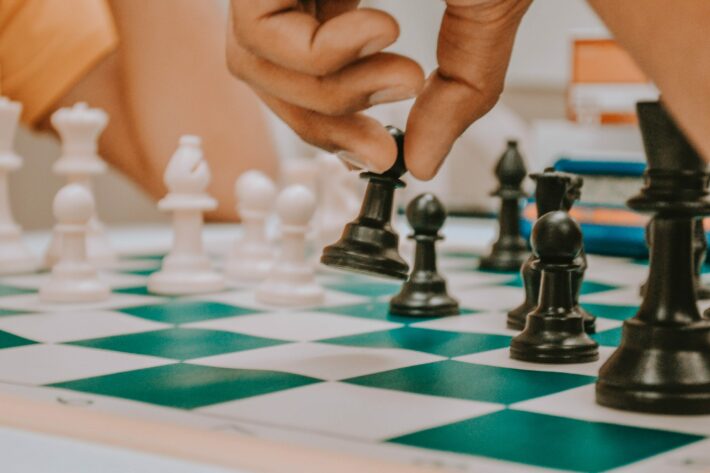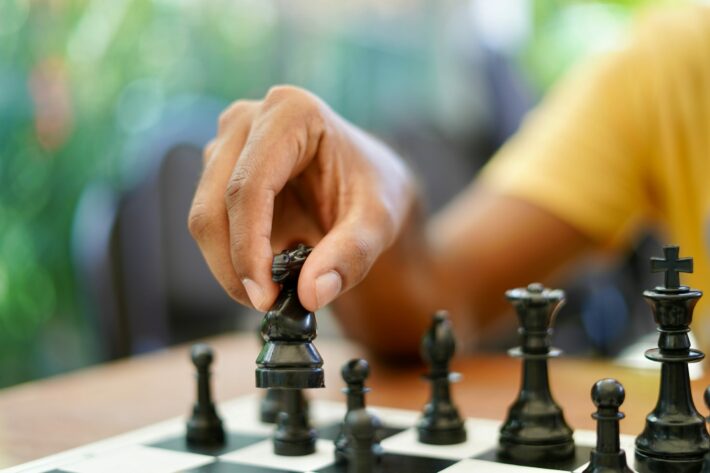Chess is a captivating game of strategy and intellect that has fascinated people for centuries. Whether you’re a complete novice or have some basic knowledge, this guide is designed to provide you with the essential tools to navigate the chessboard confidently.
From learning the rules and fundamental principles to developing tactical skills and strategic thinking, embark on this journey and unlock the secrets of chess mastery.
What are the basic rules of chess for beginners?
In chess, beginners must familiarize themselves with the fundamental rules. Each player starts with 16 pieces, including the king, queen, bishops, knights, rooks, and pawns. The objective is to checkmate the opponent’s king, which means putting it under attack with no escape route.
Pieces move in specific ways: pawns move forward, capturing diagonally; bishops move diagonally; knights move in an L-shape; rooks move horizontally or vertically; queens combine the moves of bishops and rooks; and kings move one square in any direction. Understanding these rules is crucial for beginners to grasp the game’s foundation.
How do chess pieces move on the board?

Chess pieces have distinct movement patterns. Pawns move forward one square, capturing diagonally. Bishops slide diagonally across the board, while knights move in an L-shape, leaping over other pieces. Rooks have horizontal and vertical mobility, able to traverse entire ranks and files.
The queen, the most powerful piece, can move both diagonally and horizontally/vertically. Lastly, the king can move one square in any direction. Knowing how each piece moves is vital for planning strategies, executing tactics, and maneuvering across the chessboard effectively.
What is the objective of chess and how do you win?
The objective of chess is to checkmate the opponent’s king. Checkmate occurs when the king is under attack and cannot escape capture. To achieve this, players strategize to control the board, develop their pieces, and create threats against the opponent’s king. Winning in chess requires a combination of tactics, positional understanding, and long-term planning.
It is essential to anticipate the opponent’s moves, analyze the position, and capitalize on weaknesses. By employing sound strategies and making accurate moves, players can secure victory in this intricate and intellectually stimulating game.
How can I improve my chess strategy as a beginner?
To enhance your chess strategy as a beginner, focus on several key aspects. Develop a solid understanding of opening principles, aiming to control the center and develop pieces efficiently. Study common tactical motifs such as forks, pins, and skewers to exploit the opponent’s vulnerabilities.
Cultivate good positional awareness by recognizing pawn structures, piece coordination, and the value of key squares. Analyze and learn from master games to gain insights into strategic plans and maneuvers. Regularly practice tactics puzzles to sharpen calculation and visualization skills. Consistent study, practice, and game analysis will contribute to steady improvement in chess strategy.
What are the different chess openings for beginners?
Beginners have several popular chess openings to explore. The Italian Game is a classical opening focusing on rapid piece development and center control, with moves like 1.e4 e5 2.Nf3 Nc6 3.Bc4. The Ruy-Lopez, also known as the Spanish Opening, emphasizes pawn structure and piece activity, with moves like 1.e4 e5 2.Nf3 Nc6 3.Bb5.
The Scotch Game is an aggressive option with dynamic pawn play, starting with 1.e4 e5 2.Nf3 Nc6 3.d4. The French Defense is a solid choice for Black, prioritizing central control, beginning with 1.e4 e6. The Caro-Kann Defense, starting with 1.e4 c6, offers a reliable and solid pawn structure for Black.
A Table below shows the Beginner-Friendly Chess Openings:
| Chess Opening | Description | Key Moves |
|---|---|---|
| Italian Game | The Italian Game is an opening that focuses on controlling the center of the board and developing pieces harmoniously. | 1.e4 e5 2.Nf3 Nc6 3.Bc4 |
| Ruy-Lopez | The Ruy-Lopez, also known as the Spanish Opening, is a popular choice that emphasizes solid pawn structure and piece development. | 1.e4 e5 2.Nf3 Nc6 3.Bb5 |
| Scotch Game | The Scotch Game is an aggressive opening that allows for dynamic pawn play and tactical opportunities. | 1.e4 e5 2.Nf3 Nc6 3.d4 |
| French Defense | The French Defense is a solid opening choice for Black that aims to control the center and counter White’s advance. | 1.e4 e6 |
| Caro-Kann Defense | The Caro-Kann Defense is a reliable opening that offers a solid pawn structure and defensive opportunities. | 1.e4 c6 |
How do I protect my pieces and avoid losing them?
Protecting pieces is crucial in chess to prevent unnecessary losses. Begin by considering the safety of each piece and identifying vulnerable ones. Ensure that all pieces are adequately defended and not exposed to immediate capture.
Pay attention to potential pins or skewers that could lead to material losses. Properly positioning pieces and avoiding unnecessary exchanges can also contribute to their safety. Additionally, calculating the opponent’s threats and accurately assessing risks will aid in preserving your pieces and minimizing losses on the chessboard.
What is the importance of controlling the center of the chessboard?
Controlling the center of the chessboard is of utmost importance as it provides numerous strategic advantages. Occupying the center squares (d4, d5, e4, e5) grants greater mobility to pieces, enabling quicker access to different areas of the board. It allows for effective coordination between pieces and facilitates the execution of tactical ideas.
Moreover, controlling the center allows players to influence both flanks and launch attacks in various directions. By prioritizing center control, players can establish a solid foundation for their pieces and gain a significant positional advantage in the game.
How do I develop my pieces effectively in the early game?
Developing pieces efficiently in the early game is crucial for a strong chess foundation. Start by prioritizing the development of knights and bishops, aiming to place them on active squares where they can influence the center.
Castle early to improve king safety and connect the rooks. Avoid excessive pawn moves, as they may hinder piece development. Strive for piece coordination and avoid leaving any piece idle. By following these principles, players can establish a harmonious piece setup, maximizing their potential and creating a solid platform for further strategic and tactical endeavors.
What are the key principles of pawn play in chess?
Pawns play a vital role in chess strategy. Understanding key pawn play principles can greatly enhance one’s game. Maintain a strong pawn structure by avoiding unnecessary pawn weaknesses and ensuring solid pawn chains.
Advance pawns cautiously, considering potential weaknesses and maintaining pawn cover. Utilize pawn breaks to challenge the opponent’s pawn structure and create opportunities for piece activity. Safeguard important central pawns to control key squares. Mastering these pawn play principles allows players to establish a solid foundation, control the board, and pave the way for effective strategic plans and tactical maneuvers.
How do I castle and why is it important in chess?
Castling is an essential move in chess that enhances king safety and improves rook activity. To the castle, move the king two squares towards a rook, and the rook jumps over the king to the adjacent square.
Castling ensures the king is in a more secure position, often tucked away behind a pawn shield, minimizing its vulnerability to immediate attacks. It also connects the rooks, enabling them to work together and contribute to controlling open files. Proper and timely castling can significantly enhance a player’s chances of a successful game.
How can I recognize and execute a checkmate in chess?
Recognizing and executing checkmate is a fundamental skill in chess. Look for key patterns and mating motifs such as the back-rank mate, smothered mate, or queen and rook battery. Understand the concept of king safety and weak squares around the opponent’s king. Coordinate your pieces effectively to launch a mating attack.
Utilize tactics and sacrifices to open up lines and weaken the opponent’s defenses. By studying classical checkmating patterns and developing tactical awareness, players can sharpen their ability to recognize and execute checkmate, securing decisive victories on the chessboard.
What are some common chess tactics for beginners?

Common chess tactics for beginners include forks, pins, skewers, discovered attacks, and double attacks. Forks involve attacking two pieces simultaneously, forcing the opponent to choose which one to save. Pins immobilize a piece, as moving it would expose a more valuable piece behind it.
Skewers involve attacking a valuable piece and forcing a less valuable piece in its line of attack to move. Discovered attacks occur when moving one piece reveals an attack from another piece. Double attacks target two pieces simultaneously, putting pressure on the opponent’s position and creating tactical opportunities.
How do I defend against threats and attacks in chess?
Defending against threats and attacks in chess requires vigilance and strategic thinking. Assess the severity of the threat and prioritize the defense of valuable pieces. Look for tactical solutions to neutralize or counterattack the opponent’s threats. Block the opponent’s lines of attack by placing a piece in between or by capturing the attacking piece.
Create counterthreats to divert the opponent’s attention and force them into a defensive posture. By staying alert, calculating accurately, and proactively defending your position, you can thwart your opponent’s attacks and maintain a solid defensive stance in the game.
How do I handle and create pawn structures in chess?
Handling and creating pawn structures effectively is an important aspect of chess strategy. Consider the pawn structure’s strengths and weaknesses, evaluating potential pawn breaks and pawn levers to create imbalances and open lines.
Establish pawn chains to control key squares and restrict the opponent’s piece mobility. Be cautious of isolated pawns, as they may become targets for attack. Seek to undermine the opponent’s pawn structure through tactical maneuvers and exchanges. By skillfully managing pawn structures, players can influence the position’s dynamics, create strategic opportunities, and exploit weaknesses in their opponent’s camp.
What are the different types of chess endgames and how do I approach them?
Chess endgames can be categorized into pawn endgames, rook endgames, queen endgames, and more. In pawn endgames, accurately calculating pawn races and understanding key concepts like opposition and zugzwang is crucial. Rook endgames require knowledge of concepts such as the Lucena position, Philidor position, and rook activity.
Queen endgames involve exploiting the queen’s powerful abilities to coordinate with pawns and deliver checkmates. Approaching endgames requires strategic planning, accurate calculation, and piece coordination to maximize the advantages and navigate the intricacies of each specific endgame type.
How do I calculate and anticipate my opponent’s moves in chess?
Calculating and anticipating an opponent’s moves is a vital skill in chess. Analyze the current position, identify potential threats, and evaluate possible candidate moves for your opponent. Consider the opponent’s objectives, weaknesses, and potential tactics.
Anticipate possible plans and try to understand their thought process. Visualize the consequences of different moves and variations. Develop an intuition for recognizing patterns and typical maneuvers. By honing your calculation skills, pattern recognition, and positional understanding, you can anticipate your opponent’s moves more accurately and make informed decisions in the game.
How do I study and analyze my chess games?
Studying and analyzing your chess games is a valuable way to improve. Review your games with a critical eye, identifying pivotal moments, mistakes, missed opportunities, and turning points. Analyze tactical and strategic choices, evaluating their effectiveness and exploring alternative ideas. Seek input from stronger players or chess coaches for insights and guidance.
Utilize computer chess engines to analyze positions and suggest improvements. Take notes, annotate your games, and create a personal database for future reference. Regular self-analysis and study of your games provide valuable learning experiences and contribute to steady improvement in your chess skills.
How can I improve my chess visualization and calculation skills?

Improving chess visualization and calculation skills is vital for accurate analysis and tactical proficiency. Practice mental imagery exercises to visualize the chessboard and piece placements without physically moving them. Solve chess puzzles and tactical exercises to train your calculation abilities and pattern recognition.
Play blindfold chess or mentally simulate entire games to enhance visualization and calculation under different scenarios. Gradually increase the complexity of positions and calculations as you progress. By dedicating time and effort to these exercises, you can enhance your ability to mentally explore positions and accurately calculate moves in real games.
Nevertheless
By following the steps outlined in this guide, you can quickly grasp the fundamentals and start enjoying the strategic challenges of the game. From understanding the chessboard and the unique movements of each piece to learning essential tactics and strategies, this article has provided you with a solid foundation to get started.
Remember to practice regularly, analyze your games, and continue expanding your knowledge to improve your skills. With dedication and perseverance, you’ll soon be confidently making moves and outsmarting your opponents on the chessboard.
So, don’t hesitate any longer – dive into the world of chess and embark on an enriching experience that will sharpen your mind and provide endless hours of intellectual stimulation. Start your chess journey today and unlock a world of strategic possibilities!




